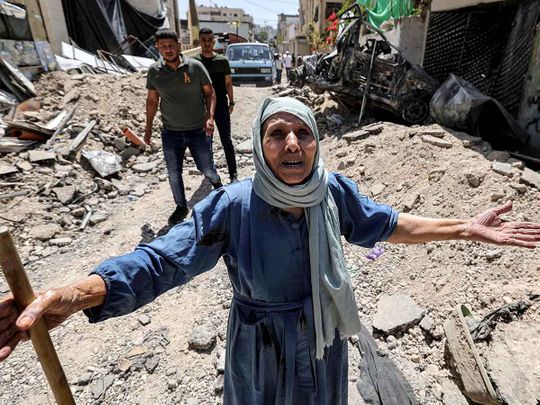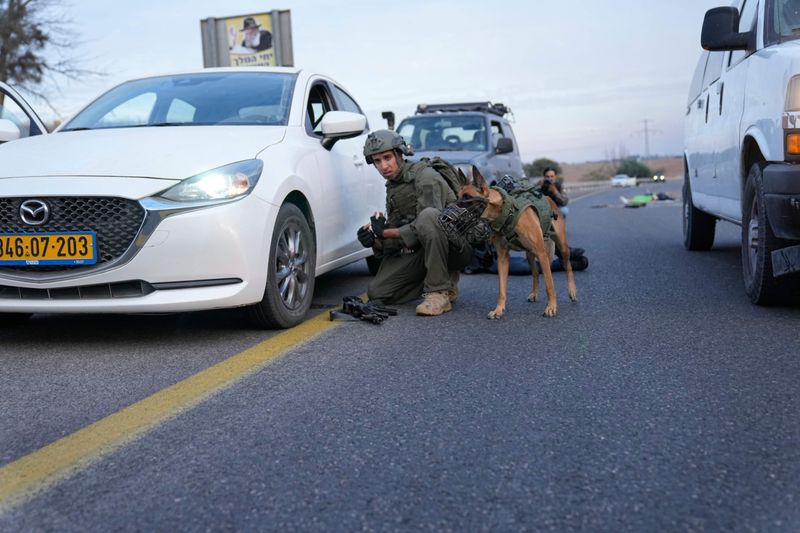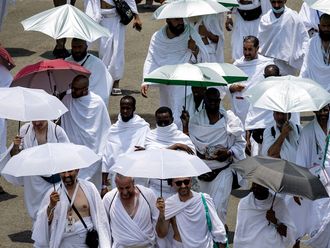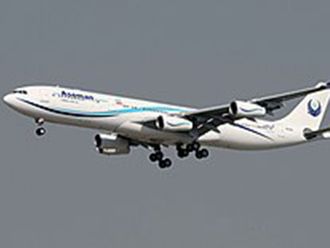
Beirut: A surprise, coordinated assault on Israel by Palestinian militants - one of the deadliest and most brazen in years - brought renewed attention to an old problem: a conflict that has vexed the Middle East for decades.
The roots of the conflict and mistrust are deep and complex, predating the establishment of the state of Israel in 1948. The past seven decades have witnessed war, uprisings and, at times, glimmers of hope for compromise.
Here is a timeline, including latest developments:
1948: Israel declares independence
A regional conflict grows amid the end of the British Mandate for Palestine and Israel’s declaration of independence in May 1948. A coalition of Arab states, allied with Palestinian factions, battle Israeli forces. In the end, Israel controls a large portion of territory. Hundreds of thousands of Palestinians flee or are driven from their land.
July 1956: The Suez Crisis
Egyptian President Jamal Abdul Nasser nationalises the Suez Canal, a vital trade route connecting the Red Sea and the Mediterranean. Israel invades Egypt, followed by forces from Britain and France. A peace deal, backed by the United States and Soviet Union, ends the fighting. But the canal was blocked by sunken ships and did not reopen until 1957.
June 1967: The ‘Six-Day War’
The “Six-Day War” begins with Israeli warplanes striking Egyptian airfields and Israeli ground forces entering the Sinai Peninsula. The war broke out amid lingering conflicts, including Egypt’s continued blockade of shipping into the Gulf of Aqaba. Jordan joins the fighting alongside Egypt, but Israeli forces have the upper hand after nearly wiping out Egypt’s air power. Israel takes control of the Gaza Strip, Sinai, the West Bank, the Golan Heights and predominantly Arab East Jerusalem. Hundreds of thousands of Palestinians flee or are displaced.
October 1973: Arab coalition attacks Israel
A coalition of Arab nations, led by Egypt and Syria, launch a surprise attack on Israel. The Arab forces initially gained ground but were driven back by an Israeli counteroffensive aided by supplies from allies, including the United States.
1978: Camp David Accords
A peace deal between Egyptian President Anwar Sadat and Israeli Prime Minister Menachem Begin, known as the Camp David Accords, is brokered on September 17, 1978, by President Jimmy Carter. Potential Palestinian peace proposals were discussed but never carried out.
December 1987: First intifada
A Palestinian uprising, or intifada, brings clashes and protests in the West Bank, Gaza and Israel. Unrest continues for years, with many killed or injured on both sides.
1993: Oslo accords
The first of two pacts, known as the Oslo accords, are signed between Israel and the Palestine Liberation Organization (PLO), setting out a peace process based on previous UN resolutions. (A follow-up accord was signed in 1995.) The agreements created the Palestinian Authority to oversee most administrative affairs in the West Bank and Gaza. The PLO is recognised by Israel and the United States as a negotiating partner. Left unresolved, however, are key issues such as Israeli settlements in the West Bank and the status of Jerusalem, which is viewed by the Palestinians as the capital of any future state.
2000: Second intifada
The second intifada, or Palestinian uprising, begins after riots broke out following a visit by right-wing Israeli political figure Ariel Sharon (later prime minister) to a compound in Jerusalem venerated in Judaism, Christianity and Islam. Clashes and other violence continue until 2005, leaving hundreds dead on both sides.
2006: Hamas elected in Gaza
The Palestinian militant group Hamas wins elections in Gaza, leading to political strains with the more moderate Fatah party controlling the West Bank.
December 2008: Israel attacks Gaza
Israel begins three weeks of attacks on Gaza after rocket barrages into Israel by Palestinian militants, who are supplied by tunnels from Egypt. More than 1,110 Palestinians and at least 13 Israelis are killed.
November 2012: Israel kills Hamas military chief
Israel kills Hamas military chief Ahmad Jabari, touching off more than a week of rocket fire from Gaza and Israeli airstrikes. At least 150 Palestinians and six Israelis are killed.
Summer 2014: Hamas kills three Israeli teenagers
Hamas militants kill three Israeli teenagers kidnapped near a Jewish settlement in the West Bank, prompting an Israeli military response. Hamas answers with rocket attacks from Gaza. A seven-week conflict leaves more than 2,200 Palestinians dead in Gaza. In Israel, 67 soldiers and six civilians are killed.
December 2017: US recognizes Jerusalem as capital
The Trump administration recognizes Jerusalem as the capital of Israel and announces that it plans to shift the US Embassy from Tel Aviv, stirring outrage from Palestinians.
2018: Protests in Gaza
Protests take place in Gaza along the fence with Israel, including demonstrators hurling rocks and gasoline bombs across the barrier. Israeli troops kill more than 170 protesters over several months. In November, Israel stages a covert raid into Gaza. At least seven suspected Palestinian militants and a senior Israeli army officer are killed. From Gaza, hundreds of rockets are fired into Israel.
May 2021: Israeli police raid Al Aqsa Mosque
After weeks of tension in Jerusalem led to Israeli police raiding Al Aqsa Mosque, one of the holiest sites in Islam, Hamas fired rockets toward the city for the first time in years, prompting Israel to retaliate with airstrikes. The fighting, the fiercest since at least 2014, saw thousands of rockets fired from Gaza and hundred of airstrikes on the Palestinian territory, with more than 200 killed in Gaza and at least 10 killed in Israel.

Spring 2022: String of terrorist attacks in Israel
A spate of violence on Israelis by Palestinians marked the deadliest string of terrorist attacks in Israel in years - with 14 Israelis killed in a handful of individual Palestinian attacks between March 22 and April 8.
In response, Israel clamped down on militants and activists, and launched the “Break the Wave” military operation in the West Bank. The operation contributed to making 2022 a particularly deadly year.
Israeli forces killed 146 Palestinians in the West Bank in 2022, a death toll higher than in any other year since the United Nations began keeping records in 2005. Israel’s Foreign Ministry said Palestinians killed 29 Israelis that year.
December 2022: Netanyahu sworn in for sixth term
Benjamin Netanyahu was sworn in again as Israeli prime minister, after winning an election that gave him his sixth term and elevated a once-fringe bloc of far-right politicians into powerful seats. He cobbled together the most far-right government in Israeli history, which critics say has already begun to eliminate any prospect of a two-state solution.
January 2023: Israeli raid on Jenin
Israeli forces raided the Palestinian city of Jenin in one of the deadliest operations in nearly two decades, engaging in a shootout and killing nine people, at least one civilian among them, on January 26. The next day, a Palestinian gunman killed seven people, including children, during prayers at an East Jerusalem synagogue.
May 2023: Airstrike attacks target top militants
Israel launched surprise airstrikes across the Gaza Strip early on the morning of May 9, targeting leaders of the Islamic Jihad militant organisation, which is backed by Iran.
The strikes killed three top militants and 10 others, according to Palestinian health officials, including four women and four children. Israel carried out the strikes a week after it reached a ceasefire with Palestinian armed factions. The Israel Defence Forces said the three senior Islamic Jihad members who were killed were responsible for recent rocket fire and attacks against Israelis.
The morning strikes set off a five-day bout of violence that killed at least 33 people in Gaza and two people in Israel. Israel and Islamic Jihad agreed to a cease-fire on May 13.
June 2023: Retaliatory attacks flare
Tit-for-tat attacks flared in June.
On June 19, Israeli forces raided Jenin, killing at least five Palestinians in a fierce firefight. Israel deployed Apache helicopters, marking the first time it turned to helicopter gunships in the West Bank since the second intifada.
The next day, two Hamas gunmen opened fire at a hummus restaurant outside Eli, an Israeli settlement in the West Bank, killing four Israelis.
On June 21, hundreds of Israeli settlers rampaged through Palestinian villages - including Turmus Ayya, where one person was killed - torching homes and cars, as well as shooting at residents, according to Turmus Ayya mayor Lafi Adeeb. Israel then also carried out its first drone strike in the West Banksince 2006, killing three suspected militants.
July 2023: Israel storms Jenin with about 1,000 troops
On July 3, Israel launched its biggest operation in the West Bank in more than two decades, staging an air and ground attack with 1,000 soldiers backed by drone strikes against a refugee camp inside Jenin. Israeli officials said they were targeting a militant “command center” in an operation that marked the start of an “extensive counterterrorism effort” that the Israel Defense Forces said would continue indefinitely.
At least eight people were killed and 80 injured, according to the Palestinian Health Ministry.
October 2023: Israel says it’s ‘at war’ after Hamas attack
Israeli Prime Minister Benjamin Netanyahu said Saturday that his country was “at war, and we will win it,” following a surprise assault by Hamas militants on the 50th anniversary of the start of the 1973 Yom Kippur war.
Israel’s air force began striking Hamas targets in Gaza after Hamas militants “infiltrated” Israeli territory from the Gaza Strip, including by paraglider and over the sea, Israeli military leaders said.






